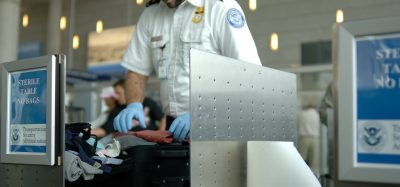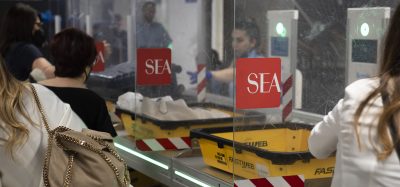What would Granny say about forming trusted partnerships?
- Like
- Digg
- Del
- Tumblr
- VKontakte
- Buffer
- Love This
- Odnoklassniki
- Meneame
- Blogger
- Amazon
- Yahoo Mail
- Gmail
- AOL
- Newsvine
- HackerNews
- Evernote
- MySpace
- Mail.ru
- Viadeo
- Line
- Comments
- Yummly
- SMS
- Viber
- Telegram
- Subscribe
- Skype
- Facebook Messenger
- Kakao
- LiveJournal
- Yammer
- Edgar
- Fintel
- Mix
- Instapaper
- Copy Link
Posted: 20 May 2016 | Neville Hay | No comments yet
Neville Hay, Aviation Security Expert, shares his input on preventing and protecting our airports and borders from terrorism and serious crime…


At a recent ACi European Avsec Committee meeting in Madrid I listened to the harrowing experience of the Brussels aviation security manager and his experience of the events on morning of 22nd March 2016. The delegates applauded him as he completed his very brave and emotional presentation. Our hearts and thoughts went out to all of those who were caught up in such unforeseen tragic circumstances and for the loss those families and loved ones have suffered.
This has inspired me to share my personal thoughts around aviation security. After 31 years of service as a police officer, my final years were spent in Special Branch; the oldest counter terrorism unit in the world formed in 1883. Its pedigree is recognised throughout the world. Its role is to assist in the protection of National Security and other sensitive issues, in addition and in my case, working closely with the UK Border officials, the National Crime Agency, law enforcement and airport security departments.
Part of my role involved the management, production and presentation of Project Griffin UK at London’s Gatwick Airport, a project under the direction of the National Counter Terrorism Security Office (NaCTSO). Project Griffin was created by the City of London Police in 2004. It was introduced to Gatwick airport in 2008. Our team took over this project in 2009 and in 2010 NaCSTO took ownership as it transformed into a UK National counter terrorism and crime programme aimed at protecting our cities and communities under the Contest Strategy of the protect and prepare strand. A pedigree, that speaks for itself.
The Project Griffin team formed a partnership with London’s Gatwick airport and supported by Sussex Police Divisional Command together we educated more than 6,500 employees and individuals connected via businesses which forms part of the infrastructure and support mechanism to the airport. This in addition includes a bespoke presentation on security awareness, counter terrorism and serious organised crime for airlines. It is without doubt the best community engagement programme that I have been involved with in my entire career of diverse policing.
Raising awareness
An awareness day is hosted at the airport every other month for the entire year. It’s a free event and is aimed at raising awareness and providing candidates with the confidence to report suspicious behaviour or activity, providing more eyes and ears within the airport community environment, this includes the greater airport community, who work at the airport and encourages these active participants to take this experience home to their communities where they live and where they will talk to friends and family.
My role within the project provided the opportunity of speaking at various international conferences on the subject of how this project works at an international airport, the busiest single runway in the world and the value it adds to the overall security of an airport environment at low cost.
Over the years our investigation of crime and terrorism, from the local to global environment, has provided a common thread highlighting that the police and security services cannot effectively operate alone. Let’s be clear they needed the help of the community. Time and time again it has been shown that the public, and community, hold the key to the door.
Stay diligent
Terrorists and criminals operate the same. There is little to differentiate between the two, they may have different agendas but they operate in similar circumstances. They plan, they organise, they require funds, assets, contacts and training, they will develop their craft in the attempt to achieve their goal. And they are not bound by rules or regulation.
Terrorists look for weaknesses and exploit them, quickly adapting from mistakes and will amend practises; but they are also creatures of habit sticking to the principles of using proven techniques. It is during this journey that they are exposed and vulnerable. It is during this journey that we, the community, can play our part. This is the time where we the community may see something that makes us take the second look or ask ourselves a question, the gut feeling, our senses talks to us, and whispers in our head something is not quite right.
In simple terms, and to coin my catchphrase, what would granny say if she knew of the circumstances?
We have all experienced this feeling in everyday life the question is what did we do? In those circumstances, the feeling can manifest itself in many different ways and in different circumstances. The objective of Project Griffin is to raise awareness and provide individuals and the community to act with confidence. It does not matter if the active participate is wrong.
Working together
Authorities need the community to help them and with this common goal a team is created. As ‘one team’ we can achieve more than one sector can by itself. Terrorists and criminals operate in our communities, they live in the community, many attack plans and events have been carried out by home grown individuals present in our communities.
We, the community, have to look at the signs and signals. It is very easy to sit in judgment after an event and start finger pointing, in the same way as the thousands of potential football referees who stand in the stadium watching from the stands, blaming the one individual on the pitch, the referee.
It is better to prevent something occurring than trying to deal with the aftermath. A small sum of funding spent on prevention is better than a large amount of funding spent on a cure. Information and intelligence are such a key element for authorities to progress and investigate. Terrorism or organised crime can never be eliminated it has been with us for thousands of years in one form or another. Terrorism today provides no warning it involves mass destruction and death.
Making a difference
Organisations globally have to work together, from the local environment to the global environment. Serious organised crime costs the state millions every year. It is seen on our streets every day through burglary, theft, fraud, prostitution, drugs and modern day slavery. The average age for child exploitation is 12 years of age. This is the age they are exposed to the sex and labour industry. Imagine if this was a member of your family – your daughter, your granddaughter. Airports and seaports are the gateways to the world and provide the opportunity for authorities to intervene in an attempt to protect our communities, our families and our children from terrorism and organised crime.
In a meeting which took place in April 2014, Secretary General Jay Grant, of IINTERPORTPOLICE at the European Air and Seaport Police Conference in Dubrovnik, Croatia, expressed his admiration for Project Griffin and had an idea – to develop stronger communications tools to assist in the dissemination of information in real-time and bring trained Griffin personnel, security and police together on a role based system. This echoed in my opinion something Project Griffin lacked; a means of communication, integrating Project Griffin with technology. Like me, he has the desire to share this best practice in an attempt to make the world a safer place. By introducing this effort to others and forming partnerships.
The INTERPORTPOLICE is about to launch Project Griffin International based upon the 11 years of best practice of Project Griffin UK and that of the National Counter Terrorism Security Office through an MOU with the City of London Police and National Executive Project Griffin Board. The purpose is to offer the project worldwide, in transportation, border and mass event security. This includes sharing a communication best practise with a community sharing capabilities. Two of the current offerings include the Airport Community and C-One smart apps. This provides for an exciting time where we can offer highly visible, proven effectiveness and lower costs within the environment as to compared to other security systems, blending an enhance security environment.
Mitigating threats
The landside threat has always been present – Paris, Domodedovo and now Brussels has shown this is very much a tactic of the terrorist. As stated before, terrorism and serious crime has been with us for centuries, we have to look at how we manage it, reducing the vulnerability, reducing the threat and risk by making it more difficult. Pushing the check-in area back from the terminal is not the answer it will just cause displacement to another target rich environment. Targeting crime has shown us that.
There is a lot of talk on how Ben Gurion carries out its security. The system employed by Israel is very different to that of other international airports, but the number of passengers travelling through it is much less than others. The security behaviour detection practice (profiling) although effective and efficient may not be accepted elsewhere. Like all practices it is taking what can add value, sometimes which means not all can be taken.
In its standards and recommended practices, the United Nation’s aviation committee, ICAO, states that each State should have a security awareness programme – but what does that mean? Each State will have its own interpretation, it will be delivered in different ways and contain differing content, but using the proven Griffin best practice offers an opportunity for a corporate programme with a base line, enabling the same message and content that can have additional themes added, the point is that the base line will be recognised as the standard. A true security awareness standard.
A holistic approach
In addition to Project Griffin International, we must look at building security into the design phase of a development, security starts at the design phase, whether a new build or an extension to an existing build. There has to be dialogue and a partnership between the architect and security, building security into the into the design will save costs. Employing practitioners is another, those who have the experience at the coal face. Cost is another feature – how much security, the type of security required? These are all questions in the design phase, future proofing, looking ahead is another. There are occasions where instead of replacing a system, complimenting it or upgrading elements may be more beneficial particularly in times of austerity.
We must also investigate how we do things, continuous improvement, evolve and reflect. We need to combine procedures and tactics to make it more hostile and difficult for the terrorist and criminal to operate within the environment and at the same time make the passengers feel welcome and safe. Using what we have, enhancing what we have without unnecessary bureaucracy and regulation which is time- consuming, at the same time we should not employ knee-jerk reactions implementing costly equipment and oversubscribed tactics without thinking of the outcomes.
To achieve some of these methods we simply have to look at the operational tactics already in place or at our disposal. The introduction of some, in my opinion, will provide the platform to ensure a security culture. Implementing a security awareness community engagement programme within or part of a security management system (SeMS) such as Project Griffin International will provide proven methods bringing the eyes and ears of the active community to our critical infrastructure. Community based a communications will bring real-time information and control where the airport authority and or police can take control providing various levels of operating and permissions, using rich media.
This includes integrating with K9 and BDOs, using CCTV with HD cameras to cover pinch points and vulnerable areas, having joint operations with all agencies as well as employing a customer service approach with our security and BDOs. Taking a lead from those known for their customer service training who are leading the way in this area, such as Emirates, Qatar, Etihad, Singapore Airlines and British Airways to name a few.
Employing volunteers is another development that should be explored and embraced, there is an aging population who possess skills and are more than willing to help, and it provides them with a sense of purpose. The Olympic Games saw the value of such volunteers. They can be utilised in the terminals and at entry points, meeting and greeting. Trained in skills, that will allow them to engage with that customer service approach, at the same time providing the additional eyes and ears on the ground. The benefit for them could be refreshment and a meal each time they are on duty.
A common platform of security awareness
Personally, with my 31 years on the job, I have seen operational and tactical individuals work effectively at strategic levels with proper development of aviation security where a difference can be made. Joint operations should be carried out periodically by all agencies working together. This will form a security culture and improve interagency operability. This was true with the shadow border police command and the introduction of the National Crime Agency, there are benefits. I am not convinced airports around the world operate in the same way or develop collaboration making use of its full potential. Some will undoubtedly operate in silos.
Some will say there is demarcation between what the police function and responsibility is and that of the airport security. To a degree this is true; however, it should not be a barrier it should be a team embracing one another, each acknowledging and enhancing their responsibilities.
To analyse what is being carried out between agencies is the same as the intelligence world from which I come from, it is not the intelligence you know, it is what you don’t know. What is the threat and risk, where is the vulnerability, how can it be reduced, how can the gaps be filled? What executive action is required to ensure there is development, lastly it has to be reviewed. Multi- agency partnerships, working together will provide a team culture filling the gaps.
Project Griffin International will assist in providing that, it provides a common platform of security awareness, not just to managers but to all who work in the airport community, it will build confidence through its awareness day. With the offering of encouragement and empowerment to individuals and a baseline to the environment’s leaders, it will also deploy a means of engagement via technology to assist in decimating and receiving information with the community, and most importantly it will build a security culture and form part of the airport risk mitigation.
In a time of crisis it will bring needed value through reliable communication within the community offering a significant resource of more eyes and ears as a primary resource to the environment; and for one of the lowest costs available. Offering greater community awareness where employee’s live, information and intelligence are all key, to preventing terrorism and serious crime.
I know what my granny would say if she knew of the circumstances, the question is what would your granny say?
















